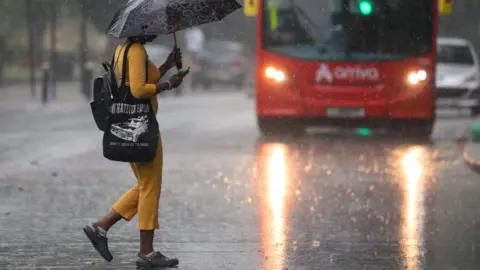### How to Stay Safe During a Storm and Handle Power Cuts
As weather patterns become increasingly unpredictable, it is vital to know how to stay safe during storms and what steps to take in the event of a power cut. Recently, the Met Office issued several warnings for thunderstorms that affect southern England, Wales, and southern Scotland, predicting intense rainfall that could lead to flash flooding. Understanding how to prepare your home and oneself during such weather is critical.
#### Preparing Your Home for a Storm
In anticipation of storms, there are several essential measures homeowners can take to protect their properties. Begin by securing any outdoor objects, including bins, ladders, trampolines, and garden tools that could become projectiles in strong winds. Inspect fences and roof tiles for stability, and ensure that gutters are clear of debris, as obstruction can lead to water damage.
It’s also prudent to eliminate any overhanging branches that could cause harm if they were to break off during a storm. Ensure that external doors and windows are secured, and if your home is fitted with storm shutters, close and fasten them before the storm arrives. Parking vehicles in a garage or far away from trees and structures may prevent damages.
Check that you know how to turn off utilities—gas, electricity, and water—in case you need to evacuate due to flooding. As an additional precaution, charge mobile phones and any critical devices, including battery packs, to remain connected with the outside world. If you take medication, be sure to stock up on supplies for several days, and gather essential documents, such as passports and insurance details, to avoid complications later.
For those in flood-risk areas, moving valuables to upper levels or placing them higher on the ground floor can save them from water damage. Staying updated on weather warnings via official channels is also crucial for timely action.
#### Conducting Yourself During a Storm
When the storm hits, prioritizing safety is key. High winds can lead to structural damage, and heavy rains may cause flooding. It’s best to stay indoors and keep internal doors closed. Unplugging non-essential electrical devices can help mitigate damage from power surges.
If you must venture outside, avoid walking near buildings or under trees to prevent injury from falling debris. The RSPCA advises bringing pets inside and ensuring they have food, water, and bedding. Always listen for updates on local weather stations or platforms, and check government websites for the latest advisories.
Should you find yourself trapped by floodwaters, seeking elevated safety within the structure is crucial, avoiding attics due to potential risks. If the flood danger escalates, contacting local emergency services should be your next step.
#### Actions to Take During a Power Cut
Experiencing a power loss can be troubling during storms. Firstly, turn off all non-essential appliances but leave at least one light on, ensuring you can see when power is restored. You can report an outage online or call 105 for assistance, a free service available in most of the UK.
If you detect a gas smell, it’s vital to report it to the emergency service at 0800 111 999. Those with medical equipment reliant on power may want to check if they can be included in a priority service list for assistance.
#### Driving Precautions in Storm Conditions
During severe weather warnings, it is advisable to refrain from driving unless necessary. Stay clear of flooded routes and exposed areas. If driving is unavoidable, ensure your vehicle is stocked with essentials, including warm clothing, water, and a fully charged mobile phone. Drive cautiously, maintain distance from other vehicles, and turn on lights in low-visibility conditions.
#### Post-Storm Recovery Steps
After the storm has passed, it’s important to assess any damage. Most home and business insurance policies cover storm-related damages, so reach out to your insurer promptly. Exercising caution around exposed electrical wires and only returning to your property when it’s genuinely safe is fundamental for your safety.
Homeowners often mistakenly believe they are responsible for all fences surrounding their property. However, it is essential to consult your title deeds to clarify boundaries, as there are no universal rules governing fence ownership. Additionally, drying out property after storm damage can take time, and redecorating should be deferred until everything is completely dry.
In conclusion, staying informed and prepared is paramount in weather-prone regions. Regularly check updates, adhere to safety guidelines, and maintain open communication with emergency services and insurance providers to ensure peace of mind before, during, and after storms.



